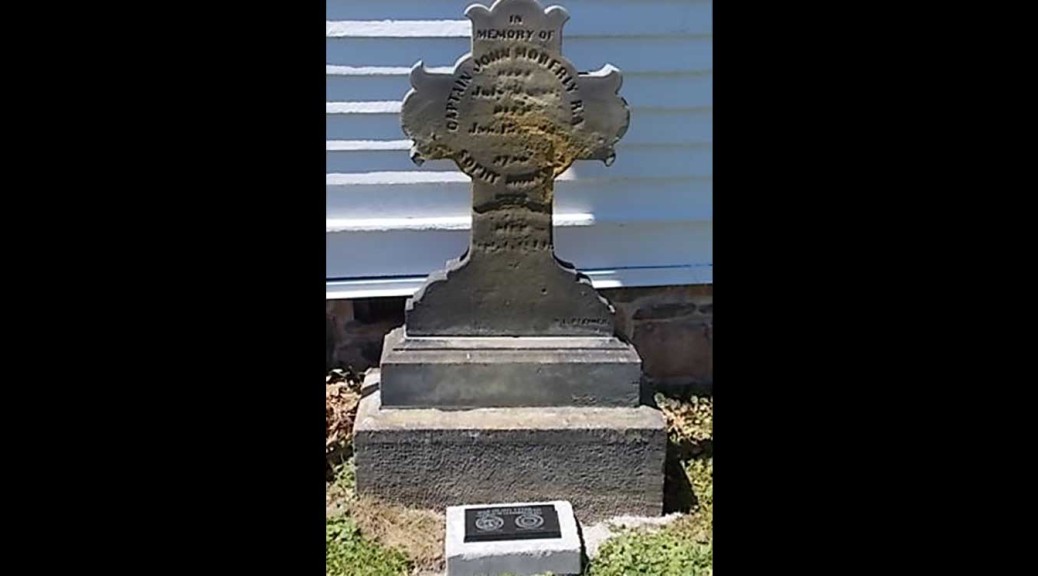Captain John Moberly was born in St. Petersburg, Russia, of English parentage, in 1789. His parents were British diplomats. He entered the navy in 1801 when he was only 12 and by 1815 had become a post Captain, serving on a number of ships.
His ship, the frigate Metampus, pursued and captured pirate vessels, helped in the capture of a French war brigantine and even played some part in the conflict at Guadeloupe. His most dramatic experience came in 1811 in a furious battle with the American frigate President, which ended with his own ship, Little Belt, reduced to a virtual wreck. Masts were smashed, sails torn apart, rigging shredded and the hull itself pierced. Thirty-two of the crew were either killed or wounded. While the ship was still reeling under this disaster, a gale got up. In this desperate situation, with decks awash and heavy waves pounding away at the battered hull, John Moberly personally worked with the men to stop the leaks and repair the masts, displaying the typical Moberly qualities of courage and resourcefulness. His coolness and inspiring leadership during these tense moments won him a mention in despatches and he was given command of his own ship, the sloop Moselle, a few years later.
It would seem that all the excitement and drama of John Moberly’s career were crowded into those early years at sea, for family history fails to record any subsequent adventures of equal note that might have added some luster to the later years of his command.
He became a commander in 1813, and a post captain in 1815.
Eventually, after thirty-one years of active naval service, he received a shore posting. But it was not in Britain that he was to spend the last years of his life. Instead, he was sent to Canada, to a remote and undeveloped harbor town on Georgian Bay in Ontario, to take charge of the little naval garrison there. Its name was Penetanguishene.
In 1834, Capt. John Moberly, was appointed to the rank of Admiral, in control of all operations appertaining to the navy, at the Penetanguishene Naval Yard on Georgian Bay. Although the naval section of the post was closed in that year, in 1835 Penetanguishene had 40 naval personnel known as a batteaux establishment for the conveyance of provisions, military stores, etc. and a general sale of craft and naval and marine appliances was ordered in 1832 and continued for some time.
While stationed in Penetanguishene, Captain Moberley was a major fundraiser for the building of an Anglican church of St. James on-the-Lines in 1837. He was later buried in the graveyard of the church. In 1825 Captain Moberly married Miss Mary Fock, daughter of General Fock of the Russian Imperial Service. She was born in Sebastopol, Crimea, where her father was then stationed. General Fock, who was a member of a Polish family of distinction, had command of the Russian Imperial Artillery at the famous Battle of Borodino in Russia which preceded Napoleon’s entrance to Moscow in 1812. Of this union were born nine children, six sons and three daughters. In 1837, Capt. Moberly was offered a commission as Colonel in a regiment at Barrie, Ontario; but as he was a sailor and not a soldier he relegated the honour to one of his sons. Capt. Moberly was appointed License Inspector for Simcoe County in 1843 and on moving to Barrie in 1844 was appointed Agent for the Bank of Upper Canada, opening the first bank branch in the County of Simcoe. He died in 1848 at Barrie at the comparatively young age of 59. Mrs. Capt. Moberly died in 1879.
Old St. James may justly be called the child of his affection, as it was principally through his efforts the church was built, and by his immediate descendants still largely maintained. In a copy of a letter dated Toronto, Sept. 18th, 1835, from Sir Richard Bonnycastle, Royal Engineers, setting apart by direction of Sir John Colborne, a church site and burying ground for the Military, and certified by Adjutant Keating, Commandant of the Post, through whom the grant was procured. Through Capt. Moberly’s exertions the late Rev. Geo. Hallen, then in Medonte, was induced to come here and assume the duties of Chaplain to the forces and the inauguration of necessary steps toward the development of a parish.
The Church Evangelist in referring some time ago to Rev. Mr. Hallen and the History of the Parish, said:
“after several years of disappointing toil, Capt. Moberly, R.N., then in command of the Naval Station at Penetanguishene, found him out and almost compelled him (Rev. Mr. Hallen) to remove to the Garrison. The church grounds were cleared and the erection began in 1836 and was completed in the early part of 1838, but not dedicated till 1840.”
An extract from a letter of the late Edgar Hallen dated Oct., 1898, says, Capt. Moberly was the founder of St. James Church and superintended the building and finishing of it.
A quaint tablet, the first erected, may still be seen in old St.James which reads as follows:
“To the memory of Lieut. Glascott, late of H. M. 66th Regt., who died Jan. 23rd, 1837, frozen to death on his return from the village after a night of festivity.
The tablet was made and erected by Capt. Moberly, R.N., who left the end vacant for the benefit of the next subaltern, who might meet a like fate.
Compiled with files from Wikipedia, Pioneer and Historical Society Simcoe County 1908, and the Establishments at Penetanguishene, Baston of the North by Elsie McLeod Jury and the Moberly family history.

